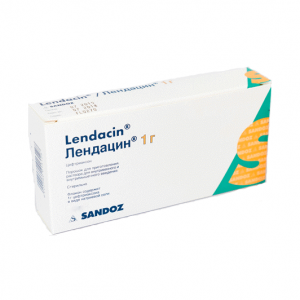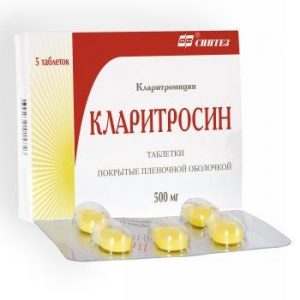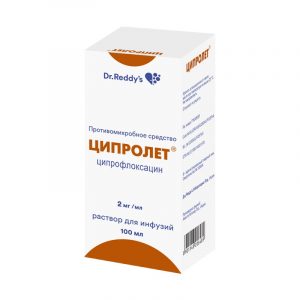Description
Latin name
GENTAMICIN
Release form
Solution for intravenous and intramuscular administration
Pharmacological action
Broad-spectrum antibiotic from the aminoglycoside group. It binds to the 30S subunit of ribosomes and disrupts protein synthesis, preventing the formation of a complex of transport and information RNA, and the genetic code is erroneously read and non-functional proteins are formed.
The drug has a bactericidal effect against many gram-positive and gram-negative microorganisms, including Pseudomonas aeruginosa, Escherichia coli, Enterobacter spp., Proteus spp., Klebsiella spp., Serratia spp., Citrobacter spp., Providencia spp., Campylobacter pylori, Campylobacter jejuni, Salmonella spp., Shigella spp., Francisella tularensis, Acinetobacter calcoaceticus, Aeromonas spp. et al.
Affects penicillin-resistant strains of Staphylococcus spr.
Microorganism resistance develops slowly, however, strains resistant to neomycin and kanamycin are also resistant to gentamicin (cross-resistance).
The drug does not affect anaerobes, fungi, viruses, protozoa.
Indications
Infectious and inflammatory diseases caused by susceptible gram-negative aerobic bacteria:
sepsis, meningitis, peritonitis, endocarditis (usually in combination with beta-lactam antibiotics)
abdominal infections: abdominal cholangitis abscesses clindamycin)
urinary tract infection
secondary burn infection, injuries and surgical interventions
tularemia
respiratory infections (pneumonia, pleural empyema, lung abscess)
prevention of postoperative infections of the abdominal cavity, especially during operations on the urinary tract and intestines.
Contraindications
hypersensitivity to the drug, drug components and other antibiotics from the aminoglycoside group
auditory nerve neuritis
myasthenia gravis
severe renal failure with uremia and azotemia due to high risk of nephritis and neonatality due to neonatality )
pregnancy and lactation.
Recommendations for use
The drug is administered intramuscularly and intravenously.
Usually the daily dose in adults with diseases of moderate severity is Zmg / kg, the frequency of administration is 2 to 3 times a day. In severe cases of the disease, the daily dose is 5 mg / kg, the frequency of administration 3-4 times a day after improvement, the dose is reduced to 3 mg / kg / day. The maximum daily dose is 5 mg / kg.
Patients with infectious and inflammatory diseases of the urinary tract and normal kidney function are prescribed once a day in a dose of 120-160 mg for 7-10 days with gonorrhea – 240-280 mg once. With a single intravenous administration of a daily dose of gentamicin, the administration time should be 30-60 minutes. With 2-x multiple administration of gentamicin: its concentration in serum before the next administration should not exceed 2 μg / ml, with a single administration – not higher than 1 μg / ml. The average duration of treatment is 7-10 days.
Children from 1 month to 12 years of age are prescribed intramuscularly or intravenously at a dose of 6 mg / kg / day in 1-3 doses.
Children over 12 years of age: intramuscularly or intravenously – 2-5 mg / kg / day in 1-3 doses.
Prevention of postoperative abdominal infections: a single dose of gentamicin in combination with metronidazole or clindamycin is prescribed for intestinal surgery.
Special instructions
The likelihood of developing nephrotoxicity is higher in patients with impaired renal function, as well as when prescribing high doses of the drug for a long time, therefore, renal function should be regularly monitored (1 or 2 times a week), and patients who have been treated for more than 10 days – daily. In order to avoid the development of hearing impairment, it is recommended to regularly (1 or 2 times a week) conduct studies of vestibular function and hearing, monitor kidney function, and also determine the concentration of gentamicin in the blood. In case of symptoms of hearing loss, the dose of the drug is reduced or treatment is stopped.
Against the background of prolonged therapy, resistance of microorganisms may develop, in which case it is necessary to cancel the drug.
Composition
Active ingredient: gentamicin sulfate 40 mg in 1 ml of solution (80 mg per ampoule)
Side effects of
Hearing and balance disturbances,
kidney damage,
headache,
nausea, vomiting,
cramps,
muscle weakness,
changes in blood cell composition (anemia, leukopenia, thrombocytopenia, granulocytopenia),
increased activity of hepatic transaminases,
hyperbilirubinemia,
allergic reactions (pruritus, urticaria).
With endolymphatic administration of gentamicin in the first minutes, a sensation of “tingling” along the lymphatic vessel may occur, which usually disappears quickly.
Drug Interactions
With simultaneous use with aminoglycosides, vancomycin, cephalosporins, ethacrylic acid, an increase in the oto- and nephrotoxic effects is possible. Enhances (mutually) the effect of carbenicillin, benzylpenicillins and cephalosporins. With simultaneous use with indomethacin, loop diuretics (including furosemide), the concentration of gentamicin in the blood plasma increases, the risk of side effects increases. Muscle relaxants increase the likelihood of respiratory paralysis. With simultaneous use with inhalation anesthesia, opioid analgesics, the risk of developing neuromuscular blockade increases up to the development of apnea.
Storage conditions
In the dark place at a temperature of no more than + 250C.
Expiration
2 years.
Deystvuyuschee substances
Gentamicin
Terms of sale from
pharmacies Prescription
Dosage form
solution for injections th and infusions
Appointment
45 by doctor’s appointment, Adult by doctor’s appointment
Indications
From urinary tract infections, From infections breathe pathways, Burns, From skin infections, From osteomyelitis
Possible product names
Gentamicin ampoules 4%, 2 ml, 10 pcs.
Dalkhimpharm, Russia



